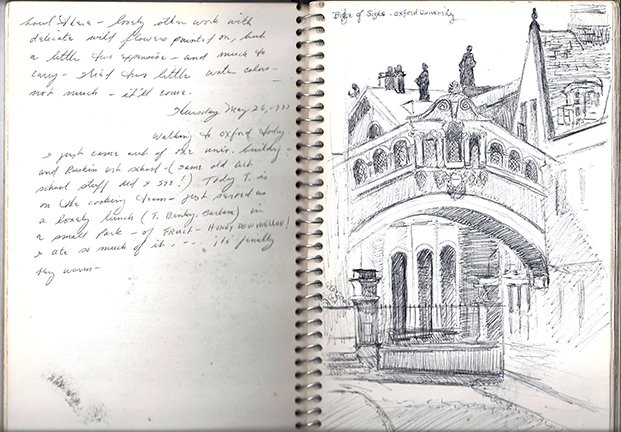An entry from the travel journal of artist Jan Dolan, on a Franklin Pierce University Walk in Europe 1977. Photograph by Lisamwoz, CC BY-SA 4.0 <https://creativecommons.org/licenses/by-sa/4.0>, via Wikimedia Commons.
Maintaining an art journal is a creative and organizational practice that can help you develop your craft and find your authorial voice. Journaling is a strategic way to get immediate thoughts and observations directly onto paper. It’s also useful as a utilitarian place to keep an up-to-date record of facts, feelings, observations, ideas, and questions that you can expand upon later.
As a former art history graduate student and current educator, I’ve used journals to support my own understanding of content-related subjects and encouraged students to use them to keep a meaningful and tangible record of what they’re learning. This type of journal has many purposes. It supplements and extends note-taking, so that it is more of an experiential and individually centered process. The journal serves as a blueprint and portfolio for all things related to the subjects you are exploring. Facts from discipline-specific work can be juxtaposed with personal thoughts and insights. Your notebook is a resource that is useful for compiling new ideas and academic tasks such as preparing for exams or formulating scholarly writings.
Keeping a journal is a multifaceted tool for fostering good critical thinking and writing skills. It is an exercise to help you develop a literary acumen without the stresses or expectations of producing a finished piece of writing. For the artist, art historian, and curator, journaling is a foundational stage for generating inspiration and taking insightful notes that describe and analyze various creative processes or works of art.
A journal is a good medium for artists to develop their craft visually, while also providing textual information that supports the aesthetics and conceptual theories within their work. This practice can be helpful for constructing artist statements, or thinking about turning ideas, mockups, and sketches into future project proposals.
A page from the author’s own interactive art history journal. This page shows preparatory notes that were used for teaching AP Art History.
The writing practice of journaling can be quite beneficial to an art historian, who is working on a formal and contextual analysis of an artwork, artist’s style, or art movement. In an art historian’s journal, they might juxtapose an image of a work they are studying and turn it into an annotated diagram replete with object or discipline-specific notes and details.
Journaling has helped me flex my literary muscles by enabling me to freely document slices of my life, and record my aspirations, and ideas without the pressure of having my writing be read or evaluated by the outside world. This process has led me to freely explore syntax and work on different ways to convey my knowledge and insights. It is a process that relies on a bit of trial and error, but the results are often worth the commitment.
If you’ve journaled before, using this technique for your artistic, scholarly, and personal practice might be somewhat familiar. Regardless of your journaling experience, here are some suggestions to help you fill your journal with inspiring and productive content.
To-do lists
Your journal can function, in part, as a planner. The to-do lists you manifest can relate to both personal and professional things that you’d like to accomplish or experience over a period of time or just in general.
Quotes and clippings
You might consider setting up a section in your journal for compiling and copying and pasting images and text. These can include anything that you come across in your work and daily life that you find useful and inspiring. Remember to cite your sources, so you can circle back to the original reference and give credit if and when you publish or produce something that incorporates them.
Subjects you are interested in
Write about your interests and how you developed a knack for them. This might include a combination of topics in your area of expertise that you’re already engaged in, as well as subjects you’d like to learn more about and perhaps become a specialist in. You can even write about writing and experiment with different literary styles that will make you sound more poetic, articulate, succinct, or scholarly. Your journal is a platform for exploration, discoveries, and insights, so the world of knowledge and expression is both literally and figuratively at the tip of your pen.
Vocabulary words you love
As a writer, it’s always befitting to expand your lexicon. As you come across words and terms that you like in other texts or conversations, jot them down. Perhaps you’ll find space for them in your future writing.
Reviews of literature, films, and exhibitions
Do you ever finish a book, come out of a movie theater, or leave a gallery with a whirlwind of thoughts and emotions swimming through your head? The next time you do, be sure to have your journal by your side so you can immediately record those reactions. These musings might come in handy as inspiration or prompts to spur your own creative output.
These suggestions are just the tip of the iceberg with regards to the personal and professional development that keeping a journal can provide. They are intended to help organize and deepen your thought process and enable you to articulate your ideas. Journaling lets you elaborate on the things you are knowledgeable and passionate about in an informal manner. In addition to giving you a sound framework for developing more formal projects and goals, it may also provide you with significant insights that can be personally inspiring and revealing.


